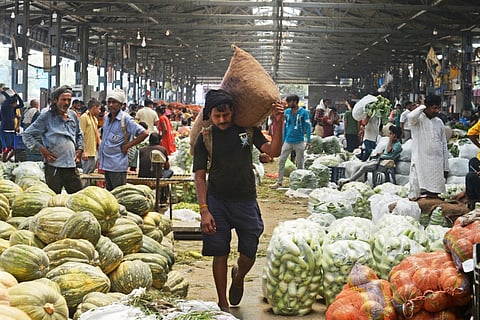

NEW DELHI: “We are human beings too. We work hard so that people like you can get fresh fruits and vegetables. Can’t the authorities provide us with a shelter or some basic facilities?” asked Ram Saran, a labourer who has spent over two decades working in the dust and chaos of Azadpur Mandi. His voice was firm, but his cracked hands and sun-worn face told the real story, a story of quiet resilience and state apathy.
Azadpur Mandi, once seen as the pride of Delhi’s food system, is today running on the sweat and silent suffering of thousands of workers like Ram. The market may be bustling from the outside, but step inside and the cracks in its foundation are wide open.
“We have been working here for almost 25 years, just to feed our families back home. If the government could provide us with basic amenities like restrooms, toilets, and water, it would be a huge help,” said Prakash Paswan, a labourer from Bihar’s Samastipur district. His words are calm, but his eyes are dry from dust and defeat.
Built by the Delhi Development Authority in 1976–77 after a fire gutted the Old Subzi Mandi, Azadpur was meant to be a well-planned wholesale hub. Instead, it now stands as a glaring reminder of how quickly workers are forgotten once the work is done. Nearly 20,000 labourers clock in every day, yet basic facilities like toilets, clean drinking water, and sleeping shelters are still missing.
“We sleep on the streets or in cramped rooms shared by ten people. By the time we finish work, we are so exhausted that we do not even feel the heat or the cold,” said Prakash.
Even as over 3 lakh people depend on the mandi, farmers, traders, porters, transporters and retailers, its infrastructure remains frozen in time. There is no proper parking. Drainage is poor. Crime is rampant. And despite the mandi’s economic importance, successive governments have allowed its core, its labour force, to live in filth.
“There is no parking system. Over 5,000 to 7,000 vehicles enter daily, but no one knows where to go. It is absolute chaos. The traffic jams stretch for hours. The drains overflow, and the smell is unbearable,” said Dillip Tiwari, a small-time businessman.
Security, too, is a concern. “Snatching happens often. Sometimes we lose our day’s wages. But what can we do? We are scared, but we cannot stop working,” said Pramod Kumar, another labourer from Uttar Pradesh.
For many of these men, Delhi is not home. It is where they earn, survive, and send money back to families in faraway villages. They work under the open sky, eat beside garbage heaps, and bathe at public taps. They are the invisible workforce powering the capital’s food supply.
When Delhi’s Chief Minister Rekha Gupta recently visited the mandi, civic workers rushed to clean the area. Drains were covered. Streets swept. “It looked neat for a day,” said a porter, adding that but the next morning, the garbage returned, the smell returned. So did the neglect.
The mandi may be nearing its golden jubilee, but for the men who load, carry, and clean, there is little to celebrate. Many have spent their entire adult lives in Azadpur without even being recognised as formal workers. There is no social security, no medical cover, no pension, and certainly no voice.
“They come here and make promises. They ask for votes. Then they forget us. We are not asking for luxuries. Just water. A toilet. A roof,” said Ram, still sitting on an overturned crate, his shirt drenched in sweat.
Labourers at Azadpur earn between Rs 300 – Rs 500 a day. There are no contracts. No unions. Injuries are common and most go untreated. If someone falls ill, they simply stop coming.
Over 3 lakh people, including 6,000 wholesalers, 20,000 laborers, 4,000-7,000 transport vehicles, and lakhs of small retailers in Delhi NCR, depend directly or indirectly on Azadpur Mandi. Not only do businessmen, farmers, transporters, and laborers depend on the mandi, but crores of buyers in the mega capital city also rely on these vegetables for their daily needs.
As the market approaches its golden jubilee (50 years), it still requires government support to improve the livelihoods of those dependent on it. The laborers continue to work tirelessly, driven by the hope of a better life. However, without support and investment in the market's infrastructure, the struggles will persist.
The story of Azadpur Mandi is one of resilience and determination. As the mandi's 50th anniversary looms, the question remains – will the government listen to the pleas of its workers, or will the market continue to thrive on the backs of those who toil in obscurity? Only time will tell. The laborers, meanwhile, will continue to work, sweat, and hope for a better tomorrow. For them, the mandi is more than just a marketplace – it is a lifeline, a chance to provide for their families and build a future.